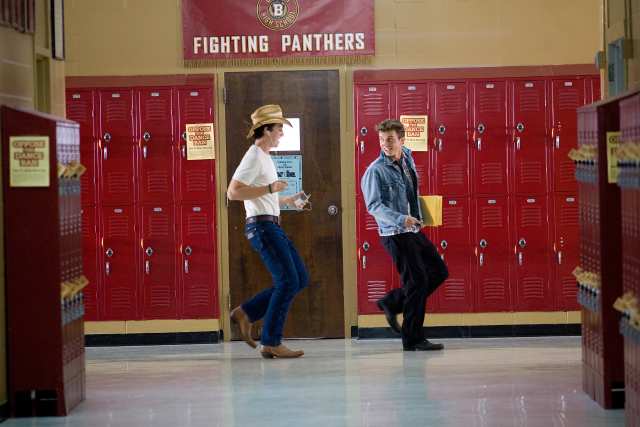
[This piece initially ran in the Los Angeles Times.]
By one measure, director Craig Brewer’s 2011 restraint and careful focus in the retelling of “Footloose” appear a success for Paramount, and a boon for the propulsion of American dance. With heralded performances by its young leads and critical appreciation of its punched-up energy, Brewer’s “Footloose” met box office projections for opening weekend — coming in at $16 million — and attracted a healthy range of mostly female viewers, from teens to the 35-49 crowd.
From the perspective of choreography and dance performances, the ax Brewer took to the original “Footloose” was badly needed. Despite our fond memories, there was barely any shelf life left in those physical outbursts. The dance and music in both “Footloose” (1984) and “Flashdance” (1983) feature an awkward hybrid of disco and new wave sensibilities — not a pretty combo. Characters’ courage and urban street smarts are evoked with a phalanx of strange skittering feet, air-boxing arms and insistent shots of soaring dismounts set to synthetic beats. In both films, the actors’ moves are poorly spliced in with the work of stunt and dance doubles.
In the new “Footloose,” Brewer and choreographer Jamal Sims have parsed the dance moments into single distinct idioms (a hip-hop scene, a line-dance scene, a group social-dance finale), and the original pop songs were re-recorded by Blake Shelton and Gretchen Wilson for a stronger country zest. The lead actors are dancers first: Kenny Wormald (as Ren McCormack) is a hunky former background dancer with Justin Timberlake and Jennifer Lopez; perky Julianne Hough (as Ariel Shaw) reigned for several years on America’s “Dancing With the Stars” as one of the more popular and successful professional partners for the celebrity invitees.
Critics have questioned these leads performers’ acting depth. But might it be the superior dance acumen throwing their performances somewhat off-balance? As the rabble-rousing Ren, Wormald dances with sublime technique and a warm, natural manner. He’s got moves and tricks beyond the norm, but with Womald it’s just conceivable that he picked them up from the street. As for Hough, playing the preacher’s wild daughter, her accomplished dance technique — paired with her perfectly trim physique — deftly kills most of the danger and small-town heartache in her character. Even when she’s grinding lustily in her Daisy Dukes, it’s hard not to see the trustworthy “DWTS” personality in Hough’s efficient frame. It makes one long for Lori Singer’s 1984 Ariel, an unknown then whose beanpole height and crazy broad shoulders spoke volumes about her defiance and vulnerability.
Still, the dancing figure cut by Hough is not the most critical one for the film’s redemptive metaphor. It is Ren’s buddy Willard who is most changed by Ren and his dancing ways — he transforms from a thuggish and defensive wallflower into an ecstatic, shape-shifting physical jester. And while it seemed impossible to imagine a substitute for Chris Penn’s act of physical illumination in the role, young Miles Teller (a more nimble, clever, scarecrow type) wins you over almost instantly.
Yet aside from Willard’s initial halting dance steps, where is the sense of bravery contained in 1984’s “Footloose”? Without the gawky bodies, without Kevin Bacon’s silly rooster strut, there’s little sense of risk or edge to the act of dancing here. Though the dance scenes will have you beaming, they may not leave you moved. To my mind, two hours of this spit-polished “Footloose” doesn’t carry half the cinematic power of Jared Hess’ raw, two-minute stage turn in “Napoleon Dynamite.”
In an interview in the New York Times, “Footloose” choreographer Sims discussed his emphasis on making the movie’s moments of dance appear “organic.” In a clear reference to America’s commitment to television dance competitions such as “DWTS” and “So You Think You Can Dance,” Sims said, “Our audiences are very dance savvy right now.”
But in this current dance bubble, America is inordinately focused on dancers, particularly ones who are “dancing for their life” — not sophisticated concert dance. The simple formula of smooth and rough edges is the addictive power of “DWTS” and “SYTYCD.” Week after week, audiences are aroused and moved when a dancer brings physical awareness and emotional dedication to choreography that falls outside their stylistic comfort zone. We tune in to see the lead-footed actor take flight, the ice princess break a sweat, the tough B-boy dance a tango.
To this end, Brewer’s over-polished “Footloose” cast just misses the mark. More regrettable, though, is the fact that Brewer and his longtime cinematographer, Amelia Vincent, didn’t use the camera to indicate the power of choreography, of patterning and texture and theme and variation. So, as it is each week on TV, we are left looking to the performer alone for the moment’s full evolutionary arc. The full shape of the dance itself has still gone missing.